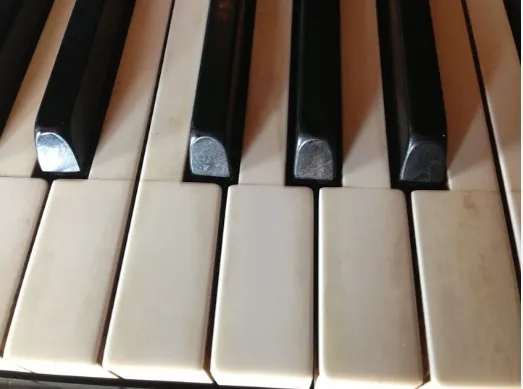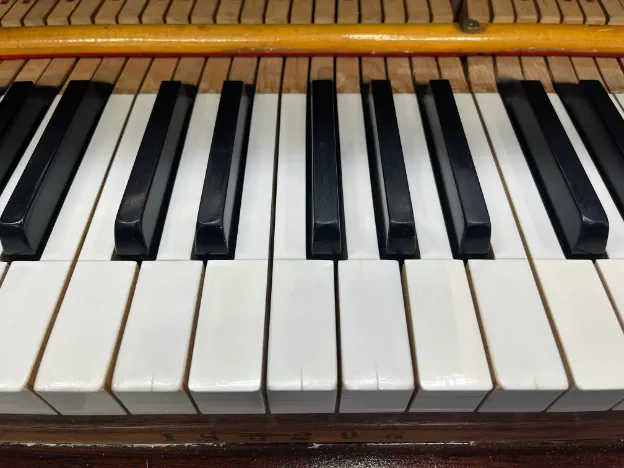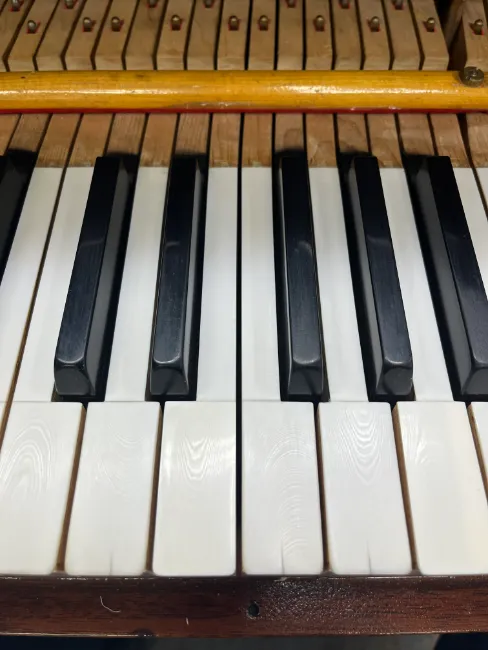How to tell if piano keys are made of ivory or plastic (20 photos)

Real ivory keytops can be sought after, but it was very common in older pianos, so it’s not unheard of to have a piano with ivory keytops.
It’s a good idea to consider whether a piano has ivory keys because it might not be preferential. It all depends on what you’re accustomed to.
It's also important if you need to repair the keytops in order to get the best results: Repairing Key Tops with Acrylikey in 10 Steps
Piano key top material has a drastically different textures. It’s incredibly important to get a feel for the keytops before choosing an instrument.
If you have a chance, go into a piano store to feel the difference between ivory, plastic, and Ivorite piano keys so you can gain insight as to what you may prefer to play on.
What do Ivory keys look like?
Ivory Keys
The most obvious sign that a piano has Ivory key tops is often that there are two pieces for each key that shows a line where the pieces are fitted together.
These two pieces of Ivory are joined together to form the surface of one key because the material is brittle and more difficult to manufacture large pieces.
Ivory piano keys appear to have a pattern on the surface of the key that looks similar to the grain on a piece of wood.
The Schreger Lines are the cross sectional patterns that look similar to the face of a two by four.
The front of Ivory keys have a significant lip as opposed to plastic keys, as a result the lip of the ivory gets chipped more often because it is brittle and protrudes further.
Clean ivory keys have an entirely different surface texture than regular plastic keys.
It is sort of counterintuitive that more friction is beneficial for piano playing keys but if you’re a piano player you’ll easily be able to tell the difference in texture/friction and it may take some getting used to.
Ivory keys give more consistent and better grip after hours of playing and are less varied in the way that it feels when playing.
Ivory keys are also less susceptible to feeling greasy; unless it has been finely polished/buffed.
It has a very consistent feel regardless of how much dirt and human hand oils end up on the keys.
Some Ivory Keys have a small split down the middle that you can see in the photo above.
Ivory tends to turn a naturally yellow grain type of color over time with dirt from fingers, however it is easy to clean them off, (Use this article to see how you can clean/whiten your ivory keys)
Click to learn How to clean piano keytops in this article I wrote.
What do plastic piano keys look like?
Plastic Keys
For the most part, plastic keys look completely flat, smooth, and may reflect light like a mirror.
Plastic keytops may be mirror-like, however some plastic keys called Ivorite have added texture which slightly changes the look of the key, we will talk later about this.
Plastic keys can be cleaned to near perfection without many blemishes and void of variances in the color.
With plastic keys, the entire top of the key is one singular topical piece of plastic because it is easier to manufacture larger pieces of plastic than it was to produce ivory, because plastic is more flexible and less brittle.
What do Ivorite keys look like?
Ivorite Keys
The following Ivorite White Keytop pictures are from Ivorite developed in the early 1980's.
Keep in mind that Ivorite on higher end Yamaha models today is a more advanced artificial ivory and you likely won't see the same wear & tear as in these photos.
The surface of the Ivorite key is less smooth and provides consistent friction which reflects less light when trying to see a reflection from the surface than in plastic piano keys.
The wear and tear you see below will not be the same from a piano that has Ivorite today, this is because the chemical composition of the material has seen significant technological advancements.
Pianists prefer a certain level of friction vs. smoothness on the keys so that their fingers move over the keys more consistently which can help with piano playing.
This is why there are piano companies that will try to imitate the feel and friction of Ivory by coming out with products like Ivorite.
For most advanced piano players, it is nice to have a certain amount of friction vs. smoothness on the key so that your fingers glide more easily over the keys.
If you look closely in the photo above, you can see vertical lines that attempt to imitate how natural ivory keys look.
Are black piano keys made of Ivory?
No.
Black keys don’t have ivory because they are painted over the wood on both older and newer pianos.
They do not have any ivory in them or on them because it only makes sense for white keys to be made out of a material such as ivory.
Is there a trade ban on Ivory?
Read about the ivory trade on Wikipedia: Ivory Trade
Pianos manufactured in Western countries discontinued the use of Ivory keys in the early 1970’s as ethical concerns began to arise, only a few decades before trade bans.
International trade bans have prohibited the sale of Ivory since 1989 and as a result, all modern pianos do not include Ivory due to ivory trade bans.
It’s much more common for antique pianos to have ivory keys because it was a preferred material to use for pianos, however it’s no longer legal to produce new pianos with ivory keys anymore.
Old Ivory keytops can be kept and saved for use on minor repair especially if it was required before the early 1980s, but cannot be directly sold as a raw material.
Ivory Facts
Are pianos made with real ivory anymore?
The main reason that ivory keys are no longer installed on new pianos is because the poaching of elephants is unethical and illegal.
Ivory comes from the tusks of elephants which is why it was decidedly unethical to include them in the production of pianos.
Are pianos with ivory worth more?
If the ivory keys on a piano are in good shape, it does not necessarily mean that it is worth a lot more, what’s more important is if it does not need additional key work to fix chipped keys which is costly.
Elephant tusks are where ivory keytops come from and is most commonly used for piano keytops.
Solid ivory is a cement dentine material similar to dental bone in that it is much more dense than regular bone.
Believe it or not, Elephants are an endangered species which is why it is critically important to continue the Ivory trade ban for all intents and purposes.
Do digital pianos have ivory?
Digital Pianos only have plastic keys which are regular plastic or Ivorite keys.
Ivorite keys are a modified plastic to feel more like ivory keys discussed earlier in this article.
All in all, Ivories are only on acoustic pianos, not digital pianos.
How can I make sure a piano does not have ivory?
If it is too difficult to see the granular texture of the key top material, it is helpful to take a magnifying glass to get a closer look, and it should become obvious whether or not the key top is plastic or ivory.
Keep in mind that you can always ask your piano technician which type of material your piano keys are made out of, he or she will surely know the answer!
In fact, you may send a photo of the piano keys to my contact information and I will happily tell you which type of keys you have.
How-To
How To Connect Yamaha Disklavier Piano To Sonos Audio System And App
How To Connect Disklavier To Alexa Using MusicCast
Quick Yamaha Disklavier DKC-900 Upgrade Manual Guide
How To Setup Yamaha Disklavier TV
How To Instructions For Dampp Chaser Pads Replacement
How To Prepare A Class At The Piano Technicians Guild Annual Convention


















